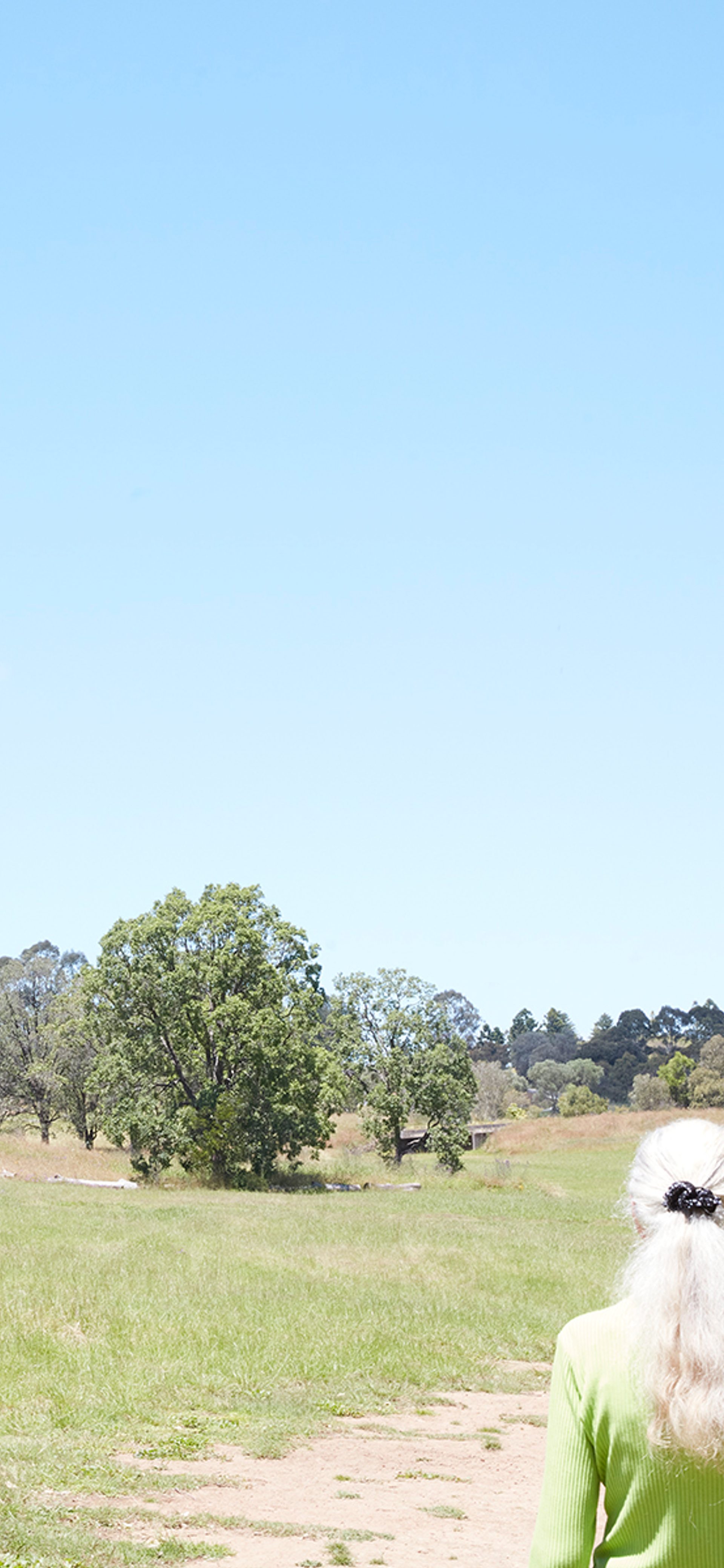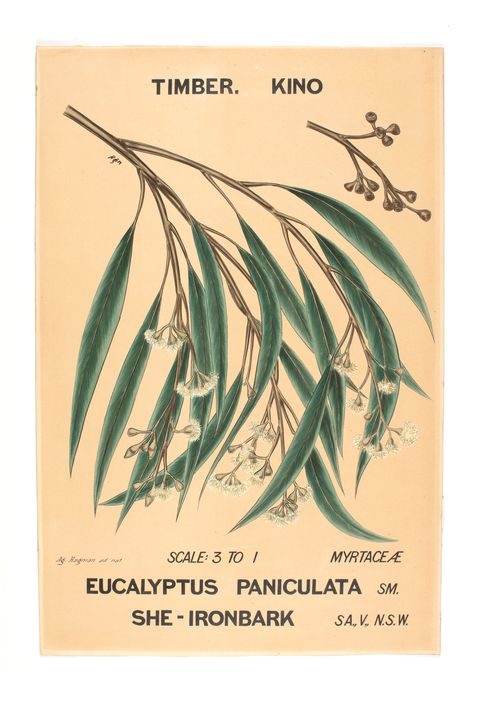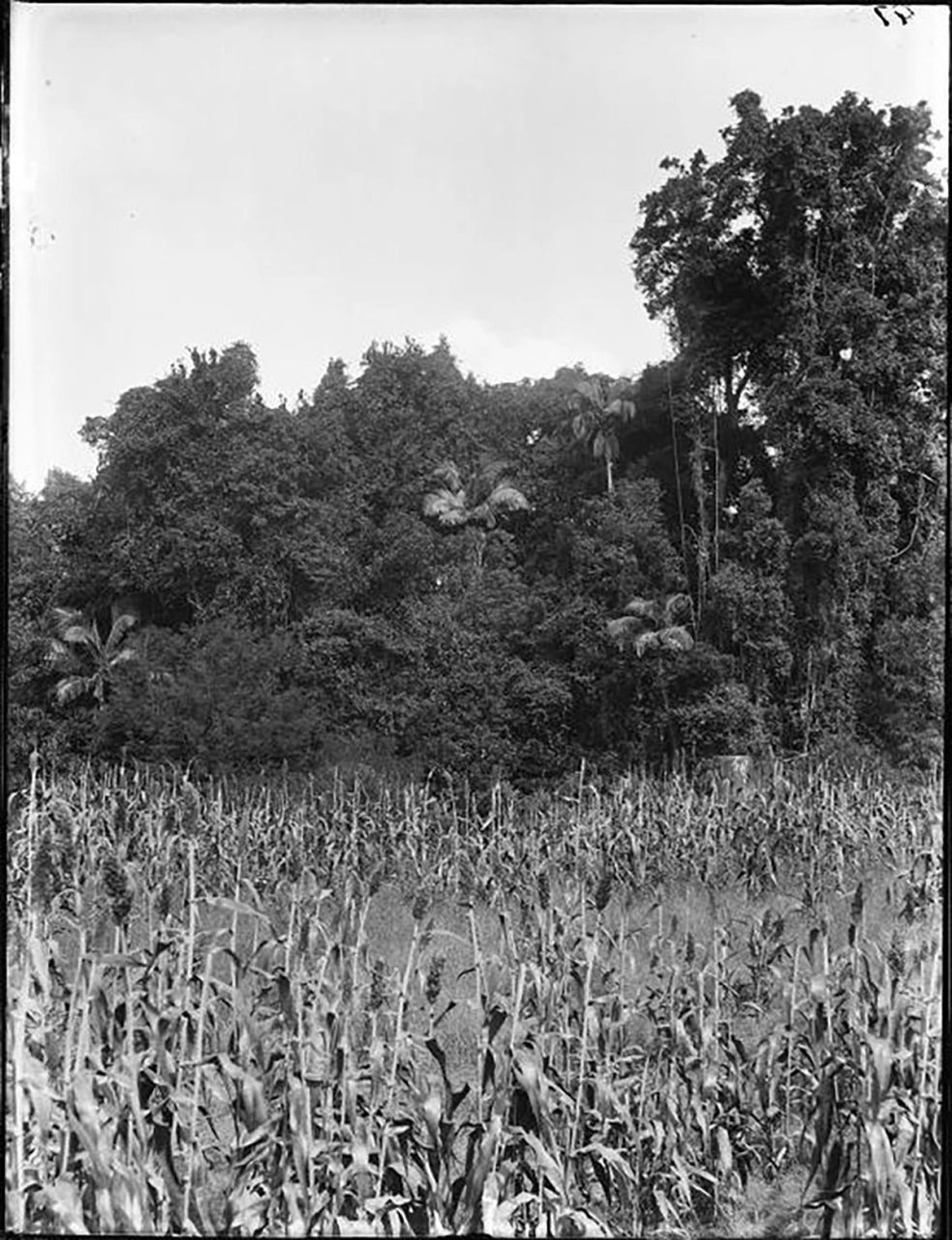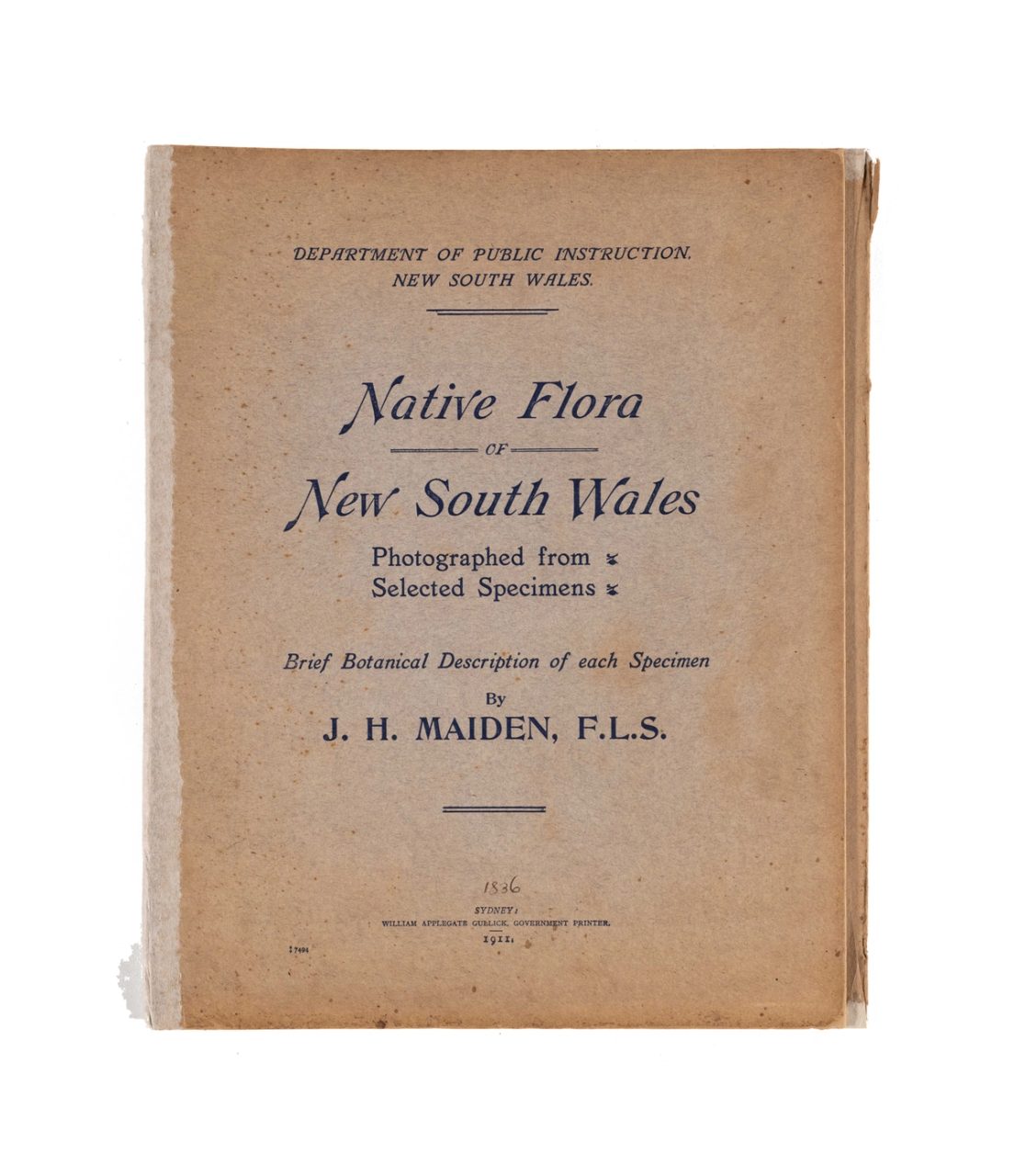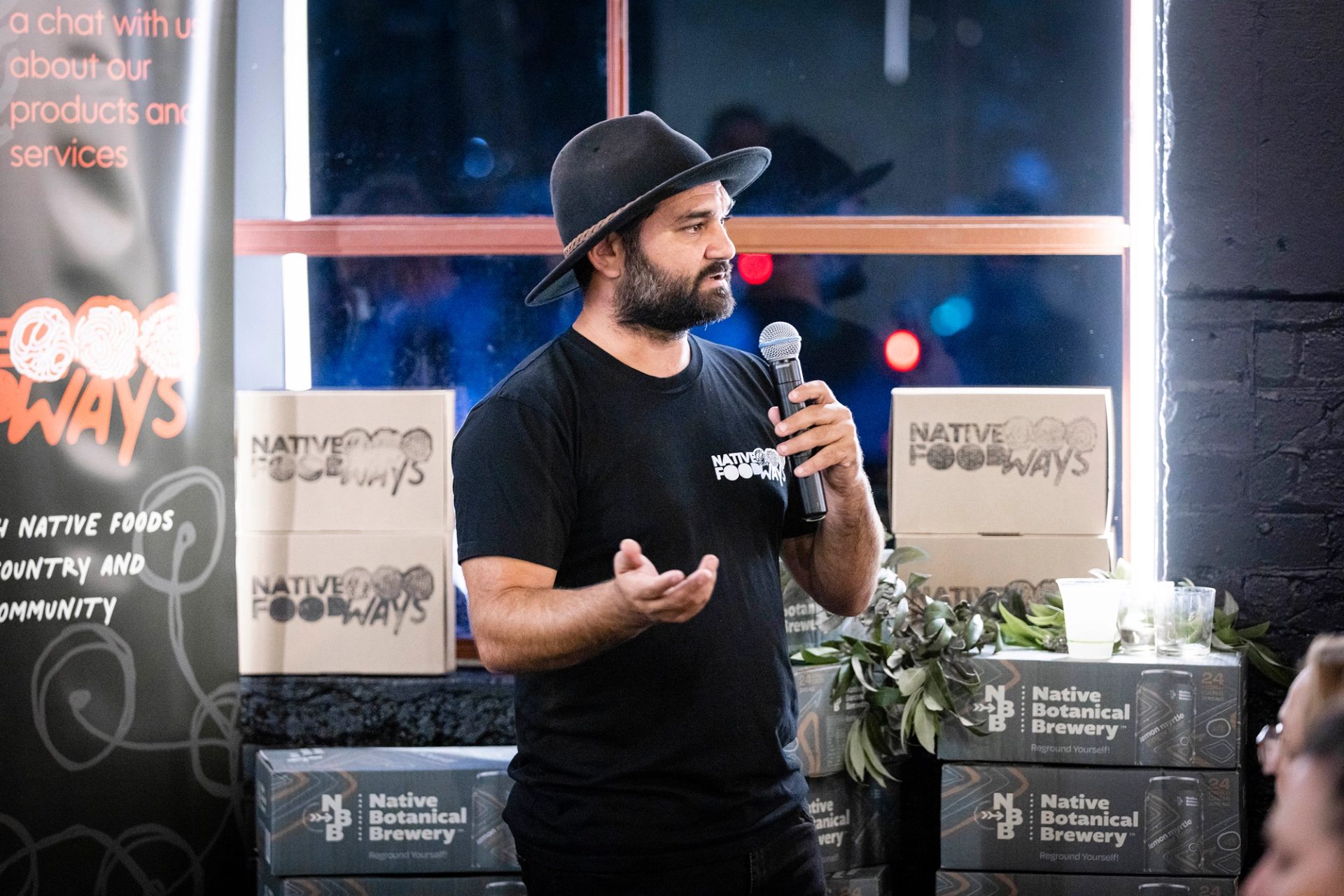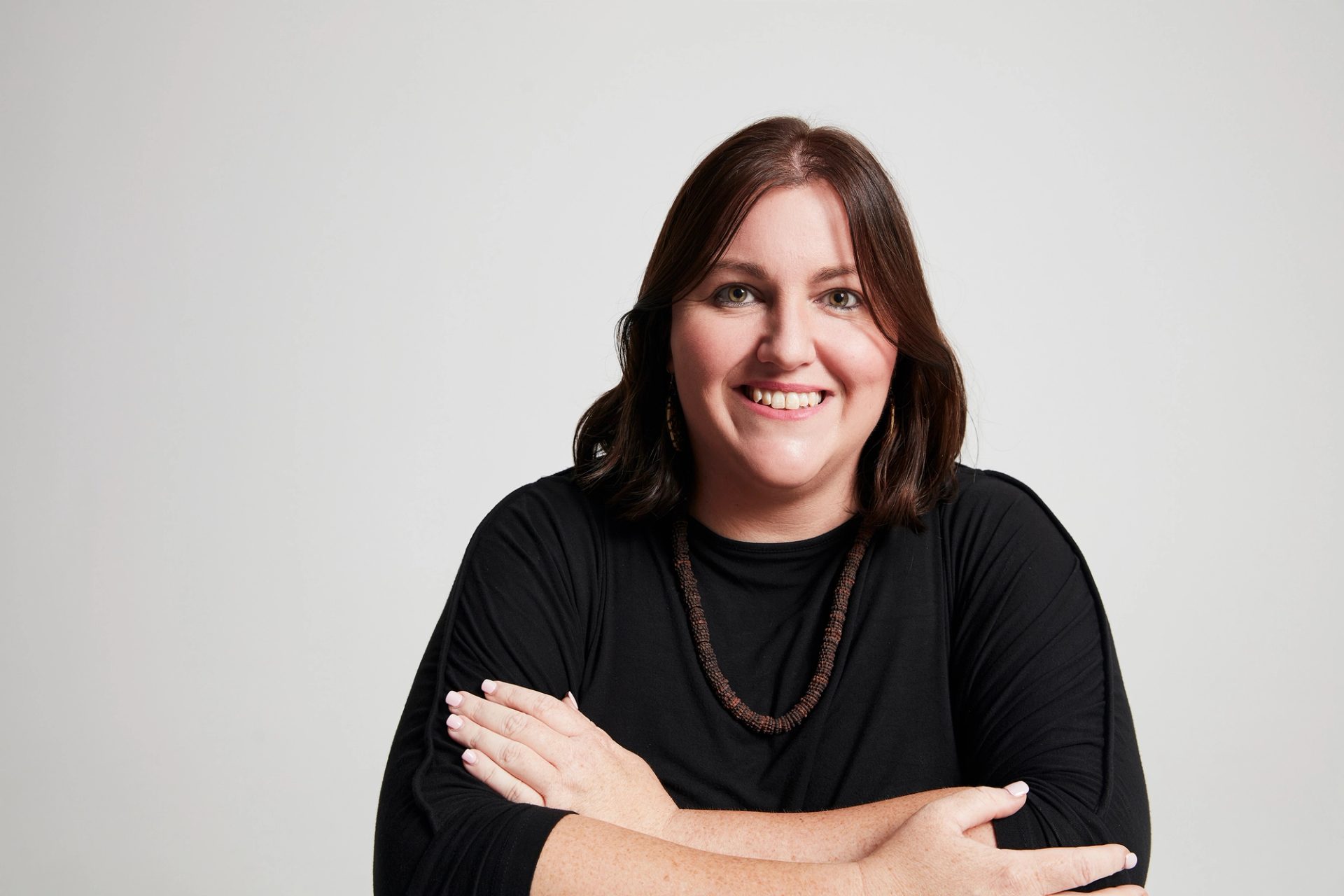Walking On Country

‘This tree is 1600 years old. She's a beautiful old thing and she can tell you the history of this place by just looking at her. I'll show you how to read it.’
Aunty Fran Bodkin, D'harawal Elder and Traditional Knowledge Holder, walks on D'harawal Country leading Emily McDaniel, inaugural director First Nations at Powerhouse and Eucalyptusdom co-curator, and Sarah Szydzik, associate director First Nations.
Eucalyptusdom
Eucalyptusdom was an exhibition at Powerhouse Ultimo that explored the eucalypt’s emergence as a symbol of Australian identity in post-Federation Australia. The exhibition took its title from a 1930s text by Edward F Swain, one of Australia’s earliest conservationists, and reckoned with our cultural history and our ever-changing relationship with the eucalypt. Eucalyptusdom presented more than 400 objects from the Powerhouse Collection, alongside 17 works that were newly commissioned for the event. These works were created by creative practitioners in the fields of design, architecture, film, applied arts, and performance.
Walking on Country
In this extract from the exhibition’s companion publication Eucalyptusdom (Powerhouse Publishing, 2022) Aunty Fran Bodkin, D'harawal Elder and Traditional Knowledge Holder, walks on D'harawal Country leading Emily McDaniel, inaugural director First Nations at Powerhouse and Eucalyptusdom co-curator, and Sarah Szydzik, associate director First Nations.
Aunty Fran Bodkin gained university degrees in environmental science, geomorphology, botany and climatology and is a dedicated community leader who played a pivotal role in agitating for the state of New South Wales to establish The Australian Botanic Garden Mount Annan in 1988.
Aunty Fran Bodkin Ironbarks are very slow growing. Their growth rate is 12 years to one of the smooth-barked eucalypt trees. Say hello to my best friend, or my second-best friend, here – who happens to be a tree. She's over 1000 years old. Don't go there because there's bull ants guarding the tree.
Emily McDaniel Is that the usual relationship between bull ant and eucalypt?
AFB Just certain species. Later I'll show you why. They're the guardians of the tree.
EMD Why is this tree so special to you, Aunt?
AFB I used to climb it all those years ago.
EMD What is this place is that we're at?
‘We are at the centre of the D'harawals. Once, before white man came here, this was a meeting ground. About every four years people from within the Sydney Basin came. But once every 11 or 12 years, depending on the sun, there was a big meeting here. And once a generation, there was an even bigger meeting where we got people from all over.’
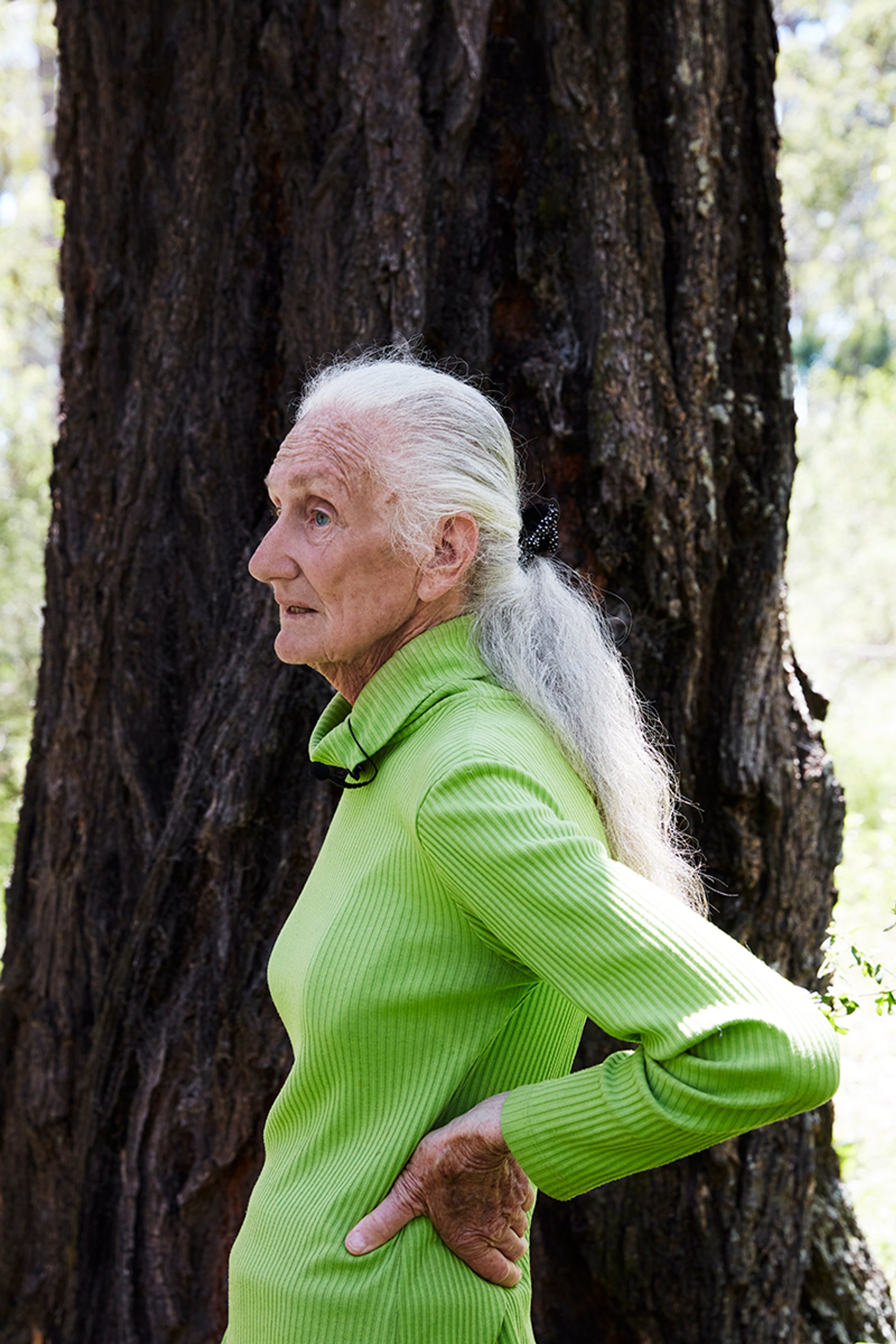
AFB The Djabugay used to come all the way down from the Northern Territory and the Cape in North Queensland for those big special meetings where everybody agreed about certain laws being the same everywhere. So you didn't break those laws, and you had to obey the laws of your own Country. Oh, there's the child of that one. I've seen this one grow from a seedling.
EMD What do you mean when you say the child?
AFB Oh, it's one of the plants from the seeds of that tree back there, the old tree.
EMD I notice that you gender plants. Sometimes they're women. Sometimes men.
AFB Yeah. Depends on the tree and what she does. Oh, there's a baby spider and here's another one.
EMD What role do spiders play in working with eucalypts?
AFB Lots of roles. They keep away a lot of the insects that are going to eat the plant. Also, they're nice to play with. These casuarina are important trees. They were trees that you could camp under. Oh, the cockatoos. Aren't they gorgeous! What they do is they chew off the seed pods and some drop down to the ground and start to grow so they replace the other tree when it dies. And they spread the seeds they ate.
EMD I'm interested in that genealogy of trees, of families, of grandmothers, daughters, granddaughters, continuing on. Last time I spoke to you, you mentioned that eucalypts have some really interesting stories connected to Country. You know, some of the warriors and guardians?
AFB Well, one of the stories that's been published is that of the Seven Warriors, about the seven different kinds of eucalypts that we classify, judged on the bark, or the appearance of the bark. They can be male or female, by the way.
Sarah Szydzik Is there a way of distinguishing them?
AFB Nah. Because it didn't matter, whatever one has the knowledge that passes allows them to become. I only know of one female guardian, but still, it's so interesting. See that tree there, that's a paperbark. Whoops, be careful of the ants because you get the smell on your feet and the other warrior ants will come after you. This here is a wattleseed. See how the little yellow sector on some of them has been taken away? That's the part that the ants eat, and once that little white bit is removed, the seed will germinate. Look they've got a big stash there outside their nest, so they'll be taking it down. That means that there's going to be some really bad weather.
SS Aunty Fran, you have so much knowledge about climate and Country. And with the tell-tale science. Did you learn that from your mother?
AFB Yes. A lot of it I did, but then when I got to uni I had the chance to really study the weather and the climate and the relationships and everything. I enjoyed it immensely and it took me on some wonderful adventures. Even scuba diving.
EMD Look how entangled those trees are.
AFB Yeah, the ironbarks. That indicates its age. Sometimes they're over 1000 years old when the branches start to curl downwards.
EMD Wow. So this one’s an old one?
AFB Oh, very old that one. I'm 86 now and I was four years old when Mum first brought me here. It wasn't a garden then. Mum made me promise that I would do my best to save this place and to save this part of the forest, and also the lookout. See all the food here, look at it all.
EMD I can't see what you see, Aunty. Will you tell me what you see?
AFB All right. These are sweet, the bulbs are very sweet and they're edible either raw or cooked.
EMD Mmmm okay.
AFB There you go, give that a shake. These were used to make baskets and mats, and the fluffy seeds were used in the babies' nappies. You'd get a strip of paperbark, and I'll show you how, put a handful of the fluffy seeds onto that strip, put the baby on top of that, fold it up between the baby's legs and tie a string around its waist. That was the very first disposable nappy and we invented it thousands upon thousands of years ago!
EMD Does this place still resemble what you remember from 80 years ago?
AFB Yes. Except the trees are fatter and taller. And there wasn't all the undergrowth, because prior to that there were cattle. But the big trees were all left and now their progeny have come up. This is very important, this ugly bush. When it's flowering, the female little beetle will climb up here and choose a few leaves and put out a perfume that attracts the male, who can fly. And he flies in and mates with her and then he dies. Then she drops down to the ground and wanders around till she finds a special spot. And then she burrows down and lays her eggs down there. Then her eggs hatch out as grubs and eventually turn into the little creatures. And they come up as an insect and they climb up there and the whole story goes around again. Look over here. There is so much that is useful, the salad plant, the sarsaparilla.
EMD Oh my goodness. What is that?
AFB It’s a weed actually.
EMD A weed, so it's introduced?
AFB It's sort of native. It's Australian, put it that way. Not here but. I can't ever remember seeing that growing here when I was little.
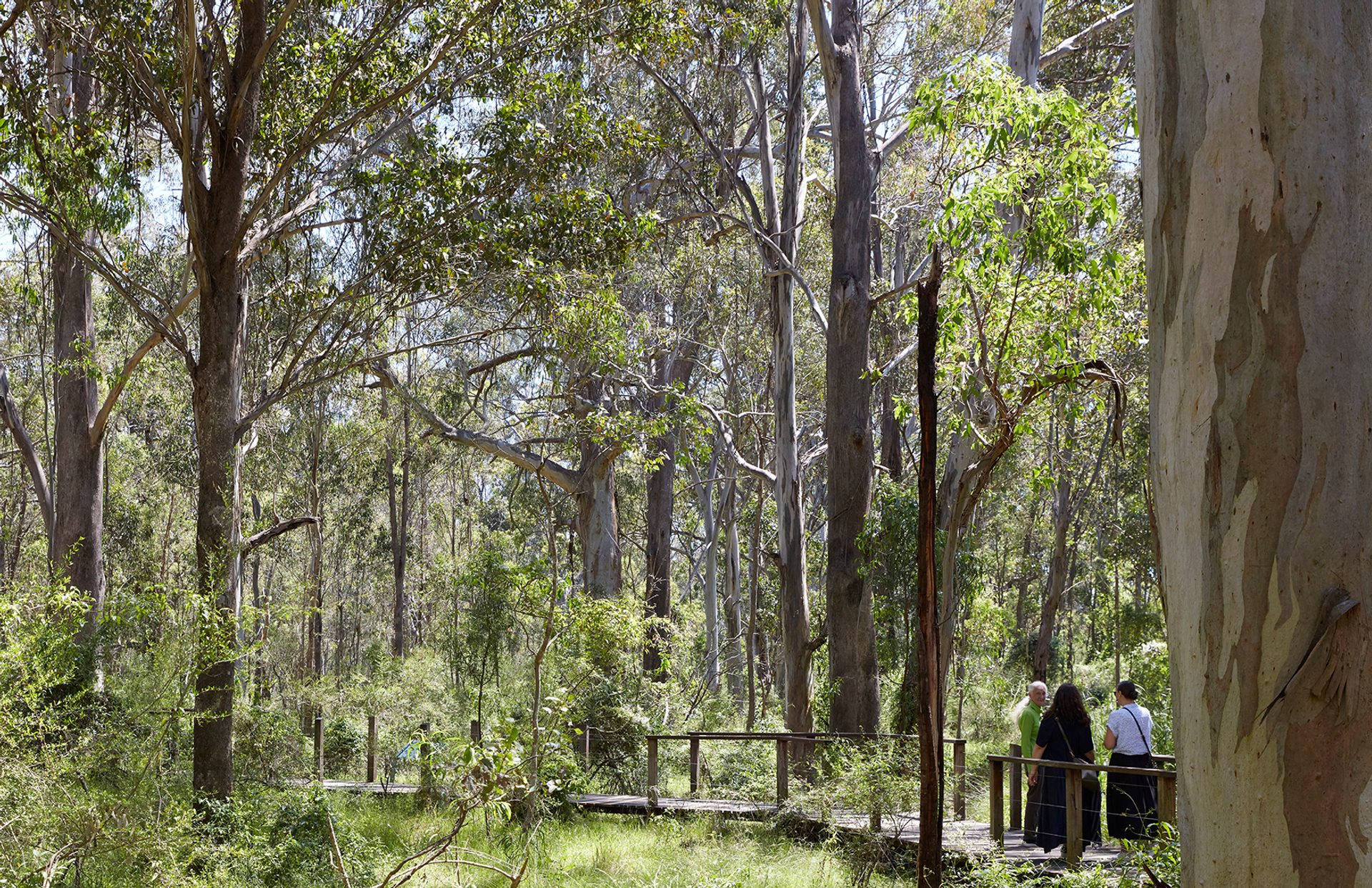
EMD A bit of movement down there.
AFB Oh, that's a little fish. The bridge used to go across here, but it rotted away.
SS Tell us a bit more about the animals and the insects that hang around the eucalypts that contribute to an association?
AFB Well, I'll show them to you. We've got several trees that we can look at. Oh, here comes someone.
EMD Is it a frog? That thumping sound?
AFB Yeah, the pop. Sounds like someone's out there. That's why a lot of the clap sticks make the noise same as the frog. C'mon, we're going off the pathway here and you're going to meet my tree. This one, all my life, from about five years of age, this is the one I've gone to and told all my troubles to. And it hasn't affected her. Actually, she's grown stronger. She's the oldest tree here, that we know of. Isn't she beautiful though?
EMD Wow. She's got an energy about her, doesn't she?
AFB Yeah, hasn't she. C'mon, I've got something else to show you over here.
EMD We're behind you, Aunt.
AFB The young ones are supposed to go ahead, so if there's any monsters they get the young ones, and the Knowledge Holders are safe! Here. She's been dropping some of her branches lately.
EMD Is it an ironbark?
AFB Yes, she's an ironbark, and she's old. I'm not quite sure how old, you can't really tell. But anyway, if you come around here, you will see the scar of a canoe in there, but the bark has grown downwards, not upwards, to cover the scar. We reckon that scar was made 1600 years ago.
EMD How do you tell these things?
AFB I don't know. I can't do that.
SS Can you show us where that scar is again, Aunt?
AFB In there, can you put your hands in it? There you go.
SS That's incredible. How did that work?
AFB They would've carved it out when it was that thick, right. I mean, this level. So that scar would be maybe 300 or 400 years old. There's another older scar around there, which has been completely covered.
SS Wow. But Aunty Fran, at the moment, we can't see any water around here?
AFB Right. I'll show you the evidence of water. Now, normally tree roots go out, spread out. Where are these roots going? What do they look like?
EMD Like a river, like they're on the banks of something.
AFB On the banks of the river that was there. Now about 2 metres down there's smooth pebbles up to that side. Being walked down from whatever was up there. Oh, look, there’s a berry down there. See that. It’s one of the poisonous ones. Got anybody you wanna kill?
SS Not today!
EMD Not in present company!
AFB That's all right then.
****
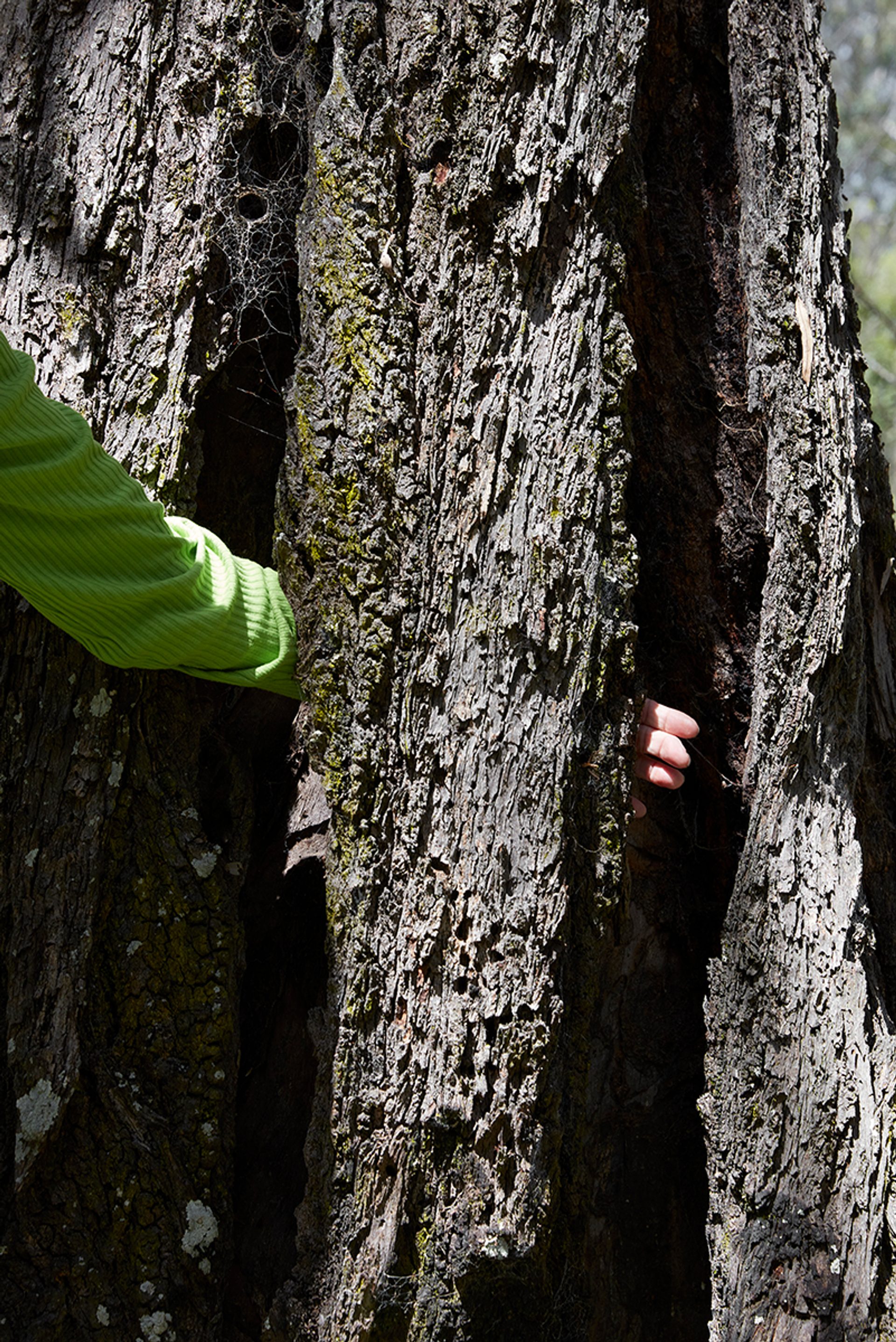
AFB But see how the branches are actually going downwards? Well, that only happens after about 500 or 600 years.
SS That's amazing. Is there any reason why they do that, Aunty Fran? Why they grow that way?
AFB They're getting old, okay. And tired, yeah.
EMD How long do you think we'll have this tree with us?
AFB Hopefully another 1000 years. Maybe more.
EMD And that can still happen? That's still a possibility?
AFB Oh, yeah. There are some older ones. Not here. I was just glad that this one was saved, or my Mum was anyway. She always said she'd put a curse on the owner if he cut this down.
SS The marking on the other side, is that from a canoe?
AFB No, this is more than likely from a shield. See the shape of this one. And there's another one, which you can just see through there. That's even older. And she's just so lovely. When we had her dated, they said at least 1600 years.
EMD Is she in an association?
AFB Yes. You need seven different species and we've got the seven here. You can see the differences. Somehow, whether it's the vapour or the leaves falling to the ground and turning to dust and then being re-absorbed, I dunno what it is, but they circulate and help each other.
EMD Does a eucalypt need its association to be healthy?
AFB A eucalypt needs an association to produce its medicines.
SS What types of medicines can it produce when it's in its association?
AFB A lot of antiseptics, medicines to help with breathing difficulties – asthma, breathing in smoke from fire, that sort of thing. Babies when they're born sometimes have trouble breathing so they're kept under the eucalypts. Not only are they stunningly beautiful, they are a hospital. All the eucalypts have different uses and wonderful health abilities. And we cut them down like mad. Even though this tree is 1600 years old, many of the leaves are younger than seven years and producing medicines. The ironbark leaf produces a great one for babies sleeping and to settle men down who are... uh, a bit too active at night.
EMD Say no more.
SS And remember, last time I spoke to you Aunty, that you mentioned that when you have an association, the Country looks a little bit different.
AFB Oh yeah... it's richer.
EMD From your experience, do you think people who work with landscape and natural environments today are aware of the importance of the association?
AFB They are not aware. They're either too lazy or they've gone to the wrong school. It's a matter of curiosity. And a lot of people today do not have curiosity. To us, curiosity is one of the most important senses that we have. The child who went out by itself and sought more knowledge or experimented with things, they were favoured over the kids who just sat and played all the time. I liked playing, I loved playing, until I realised when I wanted to run away that I needed the knowledge.
EMD And the acacias that are here, you told me once they relate to the eucalypt association in a special way. What is the acacias' role?
AFB The acacias are short lived. When the seeds come along and pour out, the birds come along, eat them, then poo out the seeds and the new tree grows. It lasts probably about 12 years, some can last up to 35 to 40 years. When the tree dies, it falls and rots away and returns all of its nutrients into the soil. And that helps build up the soil. It helps make other plants grow and makes the place look and feel beautiful. It's healthy being out here because of all the eucalypts.
****
‘When the sun shines on the leaves, it produces this beautiful vapour and each of the different species produces a different combination of chemicals. If you have a whole 'forest' of just one single species, it's not the same as a natural forest.’
AFB The medicines are stronger. Everything is better. And the soil is better too. Unfortunately, that rich soil makes the farmers want to come along and cut all the trees down.
EMD And this is what the Cumberland Plain would've looked like?
AFB It would have had fewer weeds and more useful plants – including the grasses. Later, up at the lookout, you'll see how important this place is. I'm proud that we've been able to save this. I'm disappointed that we haven't been able to save more. Still.
EMD But I think, you know, that we're able to have this conversation on Country, with you leading us through, sharing this information for us, that's testament to you upholding your Mum's wishes. Not wishes, orders rather. So, we are very thankful.
AFB Well, it is a bit scary when I think of her. I don't wanna face her when she's got a bad temper! She used to have these beautiful, bright green eyes and it was like, they'd shoot fire when she was angry. I've never seen eyes like them. And I used to, when I was little, I used to make her angry just so I could see her eyes.
EMD That's playing with fire.
AFB It was, yes. Eventually I learned.

AFB Walking through our bushland, it's healthy because you're breathing in the eucalypt vapour, which is good for you. Here you go girls. Tear this up and roll it between your hands and sniff it and then put your hands over your face and breathe in deeply. Both sides.
EMD Thank you. Then what do you do with it, Aunt? Show me.
AFB Roll it up. Rub it between your hands until your hands get warm. Now, firstly, that's a cure for a frost bite.
EMD Oh right. It's wet.
AFB Go on. Keep rubbing. Keep rubbing. Keep rubbing. Yeah. Now you can chuck it away. Put your hands over your face and breathe it in.
EMD Aaaaah. Better than Vicks! And what's that doing to your body when you breathe it in?
AFB Refreshing. And it sort of relieves tiredness too if you do enough of it. That was used by runners, messengers, to keep them going. I always used them before exams.
EMD It's not just a ceremonial thing. It changes your health and wellbeing in a physical sense, which impacts the spiritual sense. And we use different eucalypt for different purposes and each one has a different role.
AFB Yeah, that's right. And it's phenomenal each of the hundreds of eucalypt species produces different chemicals. And they produce different chemicals living next to different eucalypts.
EMD So when a eucalypt is living with another eucalypt their chemical output changes?
AFB Yup. This way. Listen to the birds.
EMD Is there a particular eucalypt that is your favourite species?
AFB Of course, the ironbarks. They're easy to climb. And they're strong, really strong wood so that you can hide safely up in the treetops. That's the native passion fruit, by the way. It's inedible. I mean, some people ate it but it's not so good. Funny taste.
EMD So tell me about seasons and ants. How do we know what weather's coming?
AFB All right. White stones covering the nest means really hot weather coming. Black stones mean really cold weather coming. What this here means is that we'll have some sunny days but we're also gunna have an awful lot of cloudy or colder ones.
EMD I love these flowers.
AFB Yeah beautiful. Their nectar is lovely too, but it's hard to get. And it makes a great wine eventually. And it has medicinal value, which is even better.
‘Here they were going to cut this down because it was dead, and I wouldn't allow them. And one season later a branch came out. See this branch here – that was the first branch that came out of tree that had been dead for 200 years.’
SS Wow. What causes these trees to die?
AFB But they're not dead. They're sleeping, okay? They're resting. If you look up the top it's also a home for possums, cockatoos and rosellas. Those branches up the top are hollow. Saving it was just so important.
EMD In European trees, they often cut off those ones at the bottom. Suckers, I think they call them. But it's not the case with these.
AFB They're attached to the roots of the actual tree. They are part of the tree. That's why they're called suckers.
EMD So we need to change how we view the tree to make sure that it can awaken itself.
AFB Yes. And that's what happened with that one. Oh, it's sort of praying anyway. But that stuff doesn't work usually. Not with trees. And as you see with the dead trunk, with the bark growing around it. It was a wonderful victory, this was probably 15 years ago. Look how high the bark is now. I was so happy with it. This is my pet tree. By the way, this is my favourite walk. Now I'll show you another old tree who's a friend of mine. Isn't she beautiful! And the ironbark growing next to it. When they grow together they grow strong and healthy. But that was broken. That was done by lightning and the brothers provided homes for the birds.
EMD So how did you come to spend so much time here? When you were younger with your mother?
AFB Mum knew the owner and she would come down here when she needed to hide me away from the child protection people who believed Aboriginal women couldn't take care of their children. Well, I tell you what, I learned more from her than I learned from school. Oh, look at the eagle! Isn't it beautiful? I'm glad it's my totem. I tried to be an eagle.
EMD Do you know what, Aunt? It's mine too.
AFB Yeah?
EMD Yeah.
AFB Oh, it's hunting something. Probably mice. Everywhere is ridden with mice at the moment. Even my house and I've got four cats. I always wanted to fly like an eagle. Oh, he's looking to see if we're edible. No, he is showing off, I think. No, that's probably what he was after. It's a frog.
‘That's the big meeting hill. That's where the women who were camped on this hill and the men, who were down in the centre of that hill over there, we would meet up there, the Elders and the oldest or the wisest would meet on top of the hill and the others, according to their level of Knowledge, would be arranged down the hill.’

AFB That's the men's hill over there. I won't take you there, but it's absolutely hollow. That's where the men used to go and do their secret stuff. They used to hide. This is where the women did their secret stuff where everyone can sit.
EMD We like to be higher, thank you.
AFB Precisely. It's also the place where you can see everything. Have any of you been here before?
EMD Yes.
SS Yes.
AFB That's the big meeting hill. That's where the women who were camped on this hill and the men, who were down in the centre of that hill over there, we would meet up there, the Elders and the oldest or the wisest would meet on top of the hill and the others, according to their level of Knowledge, would be arranged down the hill.
EMD Get a load of this magpie family up here.
AFB Yeah, they're the guardians. Aren't they beautiful! It's two of the babies up there. Not quite flying yet. He's gotta dig for the worms before we get too close. Now if you stand up here, you can see the whole of the Sydney Basin. Just have a look around. Katoomba's over that way, you can see its lights at night. And very faintly, you can see Sydney through there. And over there's the sandhills. All this is our Country. Sort of. Virtually, like over there is Mount Tomah, see the double-headed hill, that's Dharug, I think. The second or third line of hills is our boundary and then all the way down there and out to the sea. You see why they decided to put Sydney where it is. Over there, they've taken all that privet out and planted the grasses. Next time we have a busy bee we'll get right up to the top. Look at the maggies. That's their lookout. Oh, and the Monarch butterflies, this stuff is what they're propagated in. These plants are highly poisonous to most animals, but to the grubs that hatch out in there, they're their only food – which makes them poisonous to the other birds and animals. So, they're protected and that's why we have so many butterflies. There goes a maggie. You clever thing, you crashed into the branch. That over there, is Razorback. I don't recognise it because they've cleared so much of it now. It used to all be scrub and eucalypts and that, but they sold a lot of it, which is sad. That over there is Gilead, that mountain over there with all the scrub on it, that's a pathway from Wedderburn for koalas to here. And we get the old corridor, they go under the road and come up. They come here to die because it's easy food. It's wonderful because the big koala forest is probably about three or four miles that way from that mountain there. It's through bushland so they can come safely. But anyway, this is the extent of our beautiful gardens. But not necessarily forever. So what do you think of it?
SS Extraordinary.
EMD It is extraordinary.
AFB Aren't you glad we saved it?
EMD I'm glad that you did everything that you did. We're incredibly grateful.
AFB It wasn't me alone.
EMD I know, it never is. But you are the one here that we can thank. And it was a very important job.
****
Explore
First Nations
Powerhouse is committed to implementing Indigenous ways of working across all Powerhouse sites and areas of practice, including collections, curatorial, learning, public programs, design and delivery, communication, administration, operations, strategy and governance.
More










